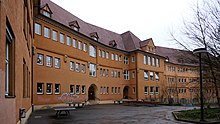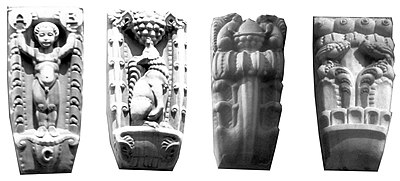Wagenburg-Gymnasium Stuttgart
| Wagenburg-Gymnasium Stuttgart | |
|---|---|

|
|
| type of school | high school |
| founding | 1914 |
| address |
Wagenburgstrasse 30 |
| place | Stuttgart ( Stuttgart-East ) |
| country | Baden-Württemberg |
| Country | Germany |
| Coordinates | 48 ° 46 '44 " N , 9 ° 11' 46" E |
| carrier | State capital Stuttgart |
| student | 543 (2017/2018) |
| Teachers | 53 (2017/2018) |
| management | Petra Wagner (since 2005) |
| Website | www.wagenburg-gymnasium.de |
The Wagenburg-Gymnasium is a high school in Stuttgart-Ost , Baden-Württemberg . The school building was inaugurated in 1914 and is a listed building.
history
After the Stuttgart school administration noticed a sharp increase in the number of pupils in the east of Stuttgart, a competition was announced in 1908 for a new building for both an elementary and community school.
The new building was inaugurated on April 24, 1914 as a boys' school. The building was planned by the Stuttgart architect Martin Elsaesser , who also designed the Stuttgart market hall . On the cornices and the east facade of the building there are reliefs by the Stuttgart sculptor Josef Zeitler , including the ABC boy and the song of Orpheus .
During the 1st World War the buildings were occupied by the military. In 1918 the community school and the Protestant elementary school were finally able to move into the entire school building. After being renamed Realschule in 1927, it became an Oberschule in 1937.
The north-west wing of the Wagenburg school and the gymnasium were destroyed by bombing raids on Stuttgart in September 1944.
On October 1, 1945, classes could be resumed in both elementary and high school. The Wagenburg high school became the Wagenburg high school in 1953/1954. Girls were admitted to the grammar school for the first time in the 1974/75 school year.
The last classes of elementary school moved out in 1976. Since then, the building has been fully used by the Wagenburg-Gymnasium. In 2012 the new gymnasium was inaugurated after a two-year construction period. (Architect: Günter Hermann)
A memorial was erected in the school in 2015 to commemorate the Jewish and discriminated pupils who were expelled from school during the Nazi era.
German-French department
In 1988 the Franco-German department was established. Since then, in addition to the German Abitur, students can also acquire the French Baccalauréat . The aim is to impart cultural and linguistic competence in both target languages.
In 2001 the Wagenburg-Gymnasium received the “Partner School for Europe” award from the Ministry of Culture. In 2006 it joined the school network “Aktion Courage” and became a “School without Racism - School with Courage”.
In 2013 the Wagenburg-Gymnasium was also included in the international school network of UNESCO as an interested UNESCO project school.
School administrators
The school was or is managed by the following directors:
- 1914–1930: Karl Pfeifle
- 1930–1938: Albert Rapp
- 1938–1945: Wilhelm Obermeyer
- 1945–1947: Emil Schwartz
- 1947–1960: Carl Maier
- 1960–1966: Heinrich Schibel
- 1967–1974: Kurt Schneiderhan
- 1974–1988: Heinrich Ströle
- 1988–2005: Helmut Dilger
- Since 2005: Petra Wagner
Former known students and teachers
architectural art
When designing the architectural jewelry for the Wagenburg School, Martin Elsaesser stuck to Goethe's saying "Only the master shows himself in the limitation". He was thus in the succession of the architect Theodor Fischer , who had planned the construction of the Stuttgart Heusteigschule "as a teaching piece for a functional and child-friendly school building". In 1904 he summarized his principles for artistic building equipment in a project description:
- "The wealth of individual training is surely superfluous from an artistic point of view, since at this point one does not expect a 'splendid building' as the beautiful word is, but primarily a useful building."
Martin Elsaesser also adhered to this maxim 10 years later when building the Wagenburg School. He avoided the danger of the monotony of the elongated, snake-like building through the protruding storeys, the transitions of which act like cornices, and through the grouping of the windows in groups of three and four on the upper floors. He limited the sculptural decoration of the building to an arcade relief, numerous corbels in relief and a circumferential eaves cornice with a tooth cut.
Arcade relief
In front of the main entrance, above the middle of the 5 arches, there is a rectangular relief by Josef Zeitler . It represents a scene from the Orpheus legend: “ Orpheus beguiles the wild animals with his song”. The naked, kneeling Orpheus is playing on his lyre. Under his legs a little bird is listening to his game, on the left a parrot, a deer and a lion are listening peacefully, on the right a wolf, an ostrich and a monkey are listening peacefully.
Corbels
The numerous corbels in relief by Josef Zeitler have no structural function, but serve to structure the facades. They are attached under the projections of the 2nd and 3rd floors, mostly between two groups of three windows and at the kinks in the facade. The corbels are divided into 4 types of relief:
- ABC boys with the letters A and B.
- Grape-eating fox.
- Two nut-nibbling squirrels.
- Bird family with 4 chicks.
See also
literature
- Modern designs, Volume 17, 1918, pages 28–40.
- Kerstin Renz: The school as an apartment. The Wagenburg high school in Stuttgart-East. In: Preservation of monuments in Baden-Württemberg 1/2015, pages 49–50 (PDF).
- Dietrich W. Schmidt (Ed.): Martin Elsaesser 1884–1957. An architect caught between Theodor Fischer and Ernst May. Stuttgart: Institute for the History of Architecture at the University of Stuttgart, 1998, pages 82-103.
- Heike Talkenberger (Ed.): The Wagenburg. A school turns 100. 1914–2014. Verlag im Ziegelhaus, Stuttgart, 2014, ISBN 978-3925440-40-3 .
- Martin Woerner; Gilbert Lupfer; Ute Schulz: Architectural Guide Stuttgart. Berlin: Reimer, 2006, page 182.
Web links
- Website of the Wagenburg-Gymnasium Stuttgart
- Jürgen Brand: 100 years of Wagenburg high school. The Wagenburg in exhibition and book. In: Stuttgarter Zeitung , October 11, 2014
Individual evidence
- ↑ a b Facts and figures about the Wagenburg-Gymnasium. In: wagenburg-gymnasium.de
- ^ Sascha Maier: Wagenburg-Gymnasium - students work through the Nazi era. In: Stuttgarter Nachrichten , January 27, 2015
- ↑ Inge Jacobs: Wagenburg-Gymnasium - A memorial commemorates former students. In: Stuttgarter Zeitung , January 25, 2015
- ↑ The German-French department at the Wagenburg-Gymnasium Stuttgart - multilingualism and intercultural learning for a Europe of tomorrow (school flyer 2017)
- ↑ Partner school for Europe - general education high school with German-French department (school flyer 2017)
- ^ Directory of school administrations, appendix p. 278, Heike Talkenberger (Ed.): Das Wagenburg. A school turns 100. 1914–2014. Verlag im Ziegelhaus, Stuttgart, 2014, ISBN 978-3925440-40-3
- ↑ #Renz 2015 , page 16.
- ^ Kerstin Krebber: The hay dough school of Theodor Fischer in Stuttgart 1904-1906. Stuttgart: Klett-Cotta, 1996, page 118.






